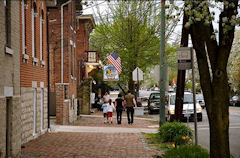
Americans pay a premium for housing in walkable neighborhoods — $850 per point on a 100-point Walkability Score scale.
The scholars over at New Geography just won’t give up trying to make the case that most Americans prefer to live in single-family detached houses in the suburbs. Citing data from the 2010 American Community Survey, Wendell Cox wrote that 79.2% of the new households in 51 major metro areas moved into precisely such housing over the past decade. He also cited data that the occupancy rate for detached housing is marginally higher than that for attached, multi-unit housing. He concluded: “The trend of the last decade is evidence of a continued preference of American households for detached housing. The results are remarkable.”
Back in September I made two key points to a similar argument advanced by Cox’s buddy, Joel Kotkin: (1) the concept of housing “preference” is meaningless in the absence of price; and (2) the movement of people into detached dwellings is as much a function of supply (what builders are allowed to build) as of demand (what people actually want at a given price point).
Now comes Emily Washington at Market Urbanism, making the same points and tying them to walkability. All other things being equal, she says, people place less value on neighborhoods with low walkability scores (typically with detached, single family dwellings), and greater value on neighborhoods with high scores (which are more likely to include multi-family dwellings). I can do no better than quote her blog post, ‘The Value of Walkability.”
While people may not cite walkabilty as an important consideration in choosing a house, choosing a home involves weighing many factors, from size, price, distance to work and other amenities, aesthetic, and countless others factors. Consumers rely on tacit knowledge to weigh many of these factors because they can’t consciously enumerate all of them in making a decision of where to live.
For this reason, revealed preference theory is a more reliable tool than survey data for observing how consumers value one attribute of a complex good like housing. Building on a past project, my colleague Eli Dourado and I are studying whether or not consumers do pay a premium for greater neighborhood walkability. Using a fixed-effects model, across all metropolitan and micropolitan statistical areas in the United States, our preliminary results indicate that, on average, Americans are willing to pay a premium of about $850 for a house with one additional point in Walk Score. Because of the many restrictions that limit walkable development, consumers have to pay this premium for the scarce supply of houses in walkable neighborhoods.
This finding also indicates that, in a world with fewer regulations limiting the supply of walkable development, the free market would provide a greater supply of walkable neighborhoods because developers have opportunities to profit from doing so that are currently prevented by regulations. In a freer market, more people would have the opportunity to live in neighborhoods where completing daily errands on foot is feasible. …
“Market suburbanists” often cite survey data finding that most people prefer detached, single family homes to living in multifamily housing. They also often say that revealed preferences back up these surveys because most Americans live in single family homes. Indeed, this is true, even in the largest cities. However, looking at the housing choices that Americans make while ignoring both regulations that limit the potential choice set and without considering the prices consumers pay is misleading, like saying Americans prefer Fords to BMWs because there are more of them on the road.
An understanding of consumers’ complex decision process in selecting a home cannot be accurately gleaned from either survey or Census data; rather, this information should be observed based on the price that emerges between buyers and sellers in the market. While, all else equal, most people might prefer a large detached house with a big yard, in weighing the many factors like proximity to amenities, price, and house size, we find that people are willing to pay a premium for walkability.
— JAB


